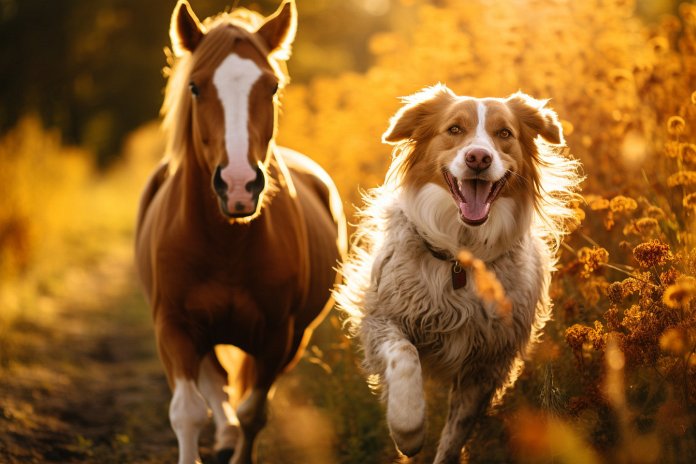
Maybe you’ve seen the perfect picture on TV – a person riding on horseback through a beautiful meadow with their happy-go-lucky dog trotting alongside. Or maybe you’ve seen a cute picture on the internet of a dog and horse cuddled up in a hay-filled stable, snoozing the day away.
Is it really possible for dogs and horses to get along that well? Sometimes, yes. Dogs have been used to help run horse farms for centuries, and dogs and horses can often be great companions for each other.
But how do you introduce your dog and horse to each other in a proper way? What signs should you look for to determine if they are getting along?
We’ve got you covered!
Below is the perfect horse-and-dog guide to help you figure out the easiest and best way to get your two animals working and living together.
Signs Your Dog and Horse Aren’t Getting Along
Normally, dogs and horses are likely to get along just fine. They both prefer companionship and as long as they are well-behaved and respectful, there shouldn’t be any issues.
However, there are cases where dogs and horses don’t get along and need to be kept apart. Here are some signals your dog might be giving you to let you know they’re not comfortable with their horse buddy.
– Anxious, nervous, or scared behavior, such as cowering, whimpering, and trying to escape the situation.
– Aggressive behavior, such as nipping, biting, growling, barking, or charging the horse out of fear.
– Wide eyes, dilated pupils, dropped back ears, raised hair on their back, and excessive pacing or panting.
Body Language
Here are some body cues your dog might be giving you to let you know they’re nervous around your horses:
– Growling
– Panting
– Pacing
– Raised hair on their back
– Biting
– Dilated pupils
Other Signs
If you’re still unsure about how your dog feels about being around your horse, look for signs like:
– Skittish behavior
– Nipping
– Unwarranted aggression
– Anxiety or panic
Dogs and Horses Through History
Throughout history, dogs and horses have worked together seamlessly. They have herded animals on cattle ranches and participated in foxhunts on the English moors. People have even chosen dogs as companions for horses due to their constant need for companionship.
The Science Behind Dog and Horse Friendships
Both dogs and horses are companion-driven animals. They are social creatures, with dogs being pack animals and horses being herd animals. It’s natural for them to seek out company, and having a companion makes them happier, healthier, and better off.
For this reason, dogs and horses work well together. Horses don’t see dogs as prey, and dogs can be trained not to nip or chase after horses. Dogs are happy to live with horses in the barn, protect and keep them company, and stay with them in the trailer or tack stall.
How to Train Your Dog and Horse to Get Along
Training your animals to get along should be relatively easy. It will require patience and love, but it’s likely that you can get them to live together harmoniously. Introduce the two animals slowly, keeping your dog on a leash during the first meeting. Start from a distance and gradually get closer.
Observe your dog’s behavior as you get nearer to the horse. Are they reacting well? When you, the dog, and the horse are face to face, allow them to sniff each other slowly. Don’t rush this process, but also don’t spend too much time on it. Let them get used to each other’s smells without any threatening behavior.
Finally, reward both the dog and the horse generously and repeat this process until they are both comfortable with each other.
“Training your dog and horse to get along is a process of patience, love, and gradual introduction. With time and positive reinforcement, these two companion animals can live together harmoniously.”

Tips & Things to Know
1️⃣ Take it slow: When introducing your dog and horse, take your time and go at a pace that is comfortable for both animals. Start with them being far apart and gradually allow them to get closer. Rushing the introduction may cause fear or aggression, so be patient and allow them to adjust at their own pace.
2️⃣ Watch for signs of discomfort: Pay attention to your dog’s body language and behavior during the introduction. Signs such as cowering, whimpering, growling, or pacing may indicate that they are not comfortable around the horse. If you notice any of these signs, it may be necessary to keep them separated or seek professional guidance.
3️⃣ Reward positive behavior: When your dog and horse are finally face to face and showing signs of comfort, reward them both generously. Positive reinforcement will help them associate each other’s presence with positive experiences. Repeat the introduction process and continue rewarding them until they are fully comfortable being around each other.
Frequently Asked Questions, Answered ✅
1. Can dogs and horses really get along?
– Yes, dogs and horses can get along well and even be companion animals for each other.
2. How do you introduce a dog and horse to each other in an appropriate way?
– Introduce them slowly and keep the dog on a leash during the first interactions. Gradually get them closer and allow them to sniff each other.
3. What are some signs that indicate the dog and horse aren’t getting along?
– Signs include anxiety, nervousness, aggression, wide eyes, dilated pupils, dropped back ears, pacing, growling, biting, and hair on the back standing up.
4. Why do dogs and horses work well together?
– Both dogs and horses are companion-driven animals and seek out company. They can provide companionship and security to each other.
5. How can you train your dog and horse to get along?
– Introduce them slowly and reward them generously for positive interactions. Repeat the process until they are both comfortable with each other.